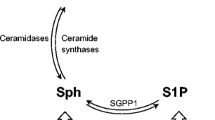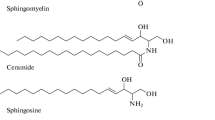Abstract
Inositol is a simple polyol with eight naturally occurring stereoisomers. myo–Inositol, D-chiro– and epi–inositol have been examined as potential therapeutic agents for various diseases, with favorable results, but treatment with scyllo–inositol has not been previously investigated. Our laboratory has shown that scyllo–inositol inhibits cognitive deficits in TgCRND8 mice and significantly ameliorates disease pathology, suggesting it might be effective in treating Alzheimer’s disease (AD). In this paper, we show that scyllo–inositol has a sustained ability to treat animals at advanced stages of AD-like pathology. Significant decreases in insoluble Aβ40, Aβ42, and plaque accumulation were observed in the brains of treated versus untreated TgCRND8 mice. The growth of plaques of all sizes was inhibited by scyllo–inositol administration. To demonstrate that the scyllo–inositol effects were within the CNS, gas chromatography/mass spectrometry was used to examine myo– and scyllo–inositol concentrations after oral administration. Further, we examined how closely scyllo– and myo–inositol are inter-regulated in the CNS and whether scyllo–inositol, if elevated within the CNS, would incorporate into phosphatidylinositol lipids. Cerebral spinal fluid levels of scyllo–inositol increased after scyllo–inositol treatment but not myo–inositol treatment. scyllo-Inositol treatment also caused increased levels of scyllo–inositol in the brain. We further show that scyllo–inositol, even at elevated levels, does not incorporate into the phosphatidylinositol family of lipids. These combined results demonstrate that scyllo–inositol accumulates within the CNS up to tenfold endogenous levels and does not interfere with phosphatidylinositol lipid production.




Similar content being viewed by others
References
Fisher SK, Novak JE, Agranoff BW (2002) Inositol and higher inositol phosphates in neural tissues: homeostasis, metabolism and functional significance. J Neurosci 82:736–754
McLaurin J, Kierstead ME, Brown ME et al (2006) Cyclohexanehexol-based inhibitors of Aβ-aggregation prevent and reverse Alzheimer-like features in a transgenic model of Alzheimer disease. Nat Med 12:801–808
Janus C, Pearson J, McLaurin J (2000) Aβ peptide immunization reduces behavioural impairment and plaques in a model of Alzheimer’s disease. Nature 408:979–982
Chishti MA, Yang D, Janus C et al (2001) Early-onset amyloid deposition and cognitive deficits in transgenic mice expressing a double mutant form of amyloid precursor protein 695. J Biol Chem 276:21562–21570
Wang J, Dickson DW, Trojanowski JQ, Lee VM-Y (1999) The levels of soluble versus insoluble brain Aβ distinguish Alzheimer’s disease from normal and pathological aging. Exp Neurol 158:328–337
Naslund J, Haroutunian V, Mohs R et al (2000) Correlation between elevated levels of amyloid β-peptide in the brain and cognitive decline. JAMA 283:1571–1577
Li R, Lindholm K, Yang L-B et al (2004) Amyloid β peptide load is correlated with increased β-secretase activity in sporadic Alzheimer’s disease patients. Proc Natl Acad Sci USA 101:3632–3637
McLaurin J, Goloumb R, Jurewicz A, Antel JP, Fraser PE (2000) Inositol stereoisomers stabilize an oligomeric aggregate of Alzheimer amyloid beta peptide and inhibit a beta-induced toxicity. J Biol Chem 275:18495–18502
Michaelis T, Helms G, Merboldt K-D, Hanicke W, Bruhn H, Frahm J (1993) Identification of scyllo–inositol in proton NMR spectra of human brain in vivo. NMR Biomed 6:105–109
Palmano KP, Whiting PH, Hawthorne JN (1977) Free and lipid myo–inositol in tissues from rats with acute and less severe streptozotocin-induced diabetes. Biochem J 167:229–235
Spector R (1978) The transport and metabolism of scyllo–inositol in the CNS. J Neurochem 31:1113–1115
Spector R (1988) myo–Inositol transport through the blood–brain barrier. Neurochem Res 13:785–787
Wiesinger H (1991) myo–Inositol transport in mouse astroglia-rich primary cultures. J Neurochem 56:1698–1704
Rubin LJ, Hale CC (1993) Characterization of a Mg-dependent, Na–inositol co-transport process in cardiac sarcolemmal vesicles. J Mol Cell Cardiol 25:721–731
Uldry M, Ibberson M, Horisberger J-D, Chatton J-Y, Riederer BM, Thorens B (2001) Identification of a mammalian H-myo–inositol symporter expressed predominantly in the brain. EMBO J 20:4467–4477
Coady MJ, Wallendorff B, Gagnon DG, Lapointe J-Y (2002) Identification of a novel Na+/myo–inositol cotransporter. J Biol Chem 277:35219–35224
Isaacks RE, Bender AS, Kim CY, Norenberg MD (1997) Effect of osmolality and myo–inositol deprivation on the transport properties of myo–inositol in primary astrocyte cultures. Neurochem Res 22:1461–1469
Benjamin J, Levine J, Fux M, Aviv A, Levy D, Belmaker RH (1995) Double-blind, placebo-controlled, crossover trial of inositol treatment for panic disorder. Am J Psychiatry 152:1084–1086
Levine J, Barak Y, Gonzalves M, Szor H, Elizur A, Kofman O, Belmaker RH (1995) Double-blind, controlled trial of inositol treatment of depression. Am J Psychiatry 152:792–794
Fux M, Levine J, Aviv A, Belmaker RH (1996) Inositol treatment of obsessive–compulsive disorder. Am J Psychiatry 153:1219–1221
Chengappa KN, Levine J, Gershon S et al (2000) Inositol as an add-on treatment for bipolar depression. Bipolar Disord 2:47–55
Gelber D, Levine J, Belmaker RH (2001) Effect of inositol on bulimia nervosa and binge eating. Int J Eat Disord 29:345–348
Palatnik A, Frolov K, Fux M, Benjamin J (2001) Double-blind, controlled, crossover trial of inositol versus fluvoxamine for the treatment of panic disorder. J Clin Psychopharmacol 21:335–339
Allan SJ, Kavanagh GM, Herd RM, Savin JA (2004) The effect of inositol supplements on the psoriasis of patients taking lithium: a randomized, placebo-controlled trial. Br J Dermatol 150:966–969
Richards MH, Belmaker RH (1996) epi–Inositol is biochemically active in reversing lithium effects on cytidine monophosphorylphosphatidate (CMP–PA). J Neural Transm 103:1281–1285
Einat H, Elkabaz-Shwortz Z, Cohen H, Kofman O, Belmaker RH (1998) Chronic epi–inositol has an anxiolytic-like effect in the plus-maze model in rats. Int J Neuropsychopharmacol 1:31–34
Cogram P, Tesh S, Tesh J, Wade A, Allan G, Greene ND, Copp AJ (2002) D-chiro–inositol is more effective than myo–inositol in preventing folate-resistant mouse neural tube defects. Hum Reprod 17:2451–2458
Kennington AS, Hill CR, Craig J, Bogardus C, Raz I, Ortmeyer HK, Hansen BC, Romero G, Larner J (1990) Low urinary chiro–inositol excretion in non-insulin-dependent diabetes mellitus. N Engl J Med 323:373–378
Ostlund RE Jr, McGill JB, Herskowitz I, Kipnis DM, Santiago JV, Sherman WR (1993) D-chiro–inositol metabolism in diabetes mellitus. Proc Natl Acad Sci USA 90:9988–9992
Larner J, Allan G, Kessler C, Reamer P, Gunn R, Huang LC (1998) Phosphoinositol glycan derived mediators and insulin resistance. Prospects for diagnosis and therapy. J Basic Clin Physiol Pharmacol 9:127–137
Nestler JE, Jakubowicz DJ, Iuorno MJ (2000) Role of inositolphosphoglycan mediators of insulin action in the polycystic ovary syndrome. J Pediatr Endocrinol Metab 13:1295–1298
Nestler JE, Jakubowicz DJ, Reamer P, Gunn RD, Allan G (1999) Ovulatory and metabolic effects of D-chiro–inositol in the polycystic ovary syndrome. N Engl J Med 340:1314–1320
Kawa JM, Przybylski R, Taylor CG (2003) Urinary chiro–inositol and myo–inositol excretion is elevated in the diabetic db/db mouse and streptozotocin diabetic rat. Exp Biol Med 228:907–914
Shetty HU, Holloway HW, Rapoport SI (1995) Capillary gas chromatography combined with ion trap detection for quantitative profiling of polyols in cerebrospinal fluid and plasma. Anal Biochem 224:279–285
Kersting MC, Boyette M, Massey JH, Ryals PE (1993) Identification of the inositol isomers present in Tetrahymena. J Eukaryot Microbiol 50:164–168
Hager K, Hazama A, Kwon HM, Loo DD, Handler JS, Wright EM (1995) Kinetics and specificity of the renal Na+/myo–inositol cotransporter expressed in Xenopus oocytes. J Membr Biol 143:103–113
Seaquist ER, Gruetter R (1998) Identification of a high concentration of scyllo–inositol in the brain of a healthy human subject using 1H- and 13C-NMR. MRM 39:313–316
Sherman WR, Stewart MA, Kurien MM, Goodwin SL (1968) The measurement of myo–inositol, myo-inosose-2 and scyllo–inositol in mammalian tissues. Biochim Biophys Acta 158:197–205
Sherman WR, Stewart MA, Simpson PC, Goodwin SL (1968) The identification of myo-inosose-2 and scyllo–inositol in mammalian tissues. Biochemistry 7:819–824
Hipps PP, Holland WH, Sherman WR (1977) Interconversion of myo– and scyllo–inositol with simultaneous formation of neo–inositol by an NADP+ dependent epimerase from bovine brain. Biochem Biophys Res Commun 77:340–346
Groenen PMW, Merkus HMWM, Sweep FCGJ, Wevers RA, Janssen FSM, Steegers-Theunissen RPM (2003) Kinetics of myo–inositol loading in women of reproductive age. Ann Clin Biochem 40:79–85
Pak Y, Huang LC, Lilley KJ, Larner J (1992) In vivo conversion of [3H]myoinositol to [3H]chiroinositol in rat tissues. J Biol Chem 267:16904–16910
Inoue K, Shimada S, Minami Y, Morimura H, Miyai A, Yamauchi A, Tohyama M (1996) Cellular localization of Na+/myo–inositol co-transporter mRNA in the rat brain. NeuroReport 7:1195–1198
Kaiser LG, Schuff N, Cashdollar N, Weiner MW (2005) scyllo–Inositol in normal aging human brain: 1H magnetic resonance spectroscopy study at 4 Tesla. NMR Biomed 18:51–55
Frahm J, Bruhn H, Hanicke W, Merboldt KD, Mursch K, Markakis E (1991) Localized proton NMR spectroscopy of brain tumors using short-echo time STEAM sequences. J Comput Assist Tomogr 15:915–922
Meyerhoff D, Fein G, Weiner M (1996) Elevated scyllo–inositol in adult human brain. In: Proc ISMRM, 4th Scientific Meeting, New York, pp 954
Ryals PE, Kersting MC (1999) Sodium-dependent uptake of [3H]scyllo–inositol by Tetrahymena: incorporation into phosphatidylinositol, phosphatidylinositol-linked glycans, and polyphosphoinositols. Arch Biochem Biophys 366:261–266
Murthy PPN, Pliska-Matyshak G, Keranen LM, Lam P, Mueller HH, Bhuvarahamurthy N (1992) Evidence of two isomers of phosphatidylinositol in plant tissue. Plant Physiol 98:1498–1501
Kinnard RL, Narasimhan B, Pliska-Matyshak G, Murthy PPN (1995) Characterization of scyllo–inositol-containing phosphatidylinositol in plant cells. Biochem Biophys Res Commun 210:549–555
Acknowledgment
The authors would like to thank the staff at the Analest Center, Chemistry Department University of Toronto, for the advice on the GC/MS and the staff at the Division of Comparative Medicine at the University of Toronto. The authors acknowledge support from the Ontario Alzheimer’s Society (J.M.), Canadian Institutes of Health Research (J.M.), Natural Science and Engineering Research Council of Canada (J.M.), Ontario Graduate Scholarship (D.F.), and Scottish Rite Charitable Foundation Graduate Fellowship (D.F.).
Author information
Authors and Affiliations
Corresponding author
Rights and permissions
About this article
Cite this article
Fenili, D., Brown, M., Rappaport, R. et al. Properties of scyllo–inositol as a therapeutic treatment of AD-like pathology. J Mol Med 85, 603–611 (2007). https://doi.org/10.1007/s00109-007-0156-7
Received:
Revised:
Accepted:
Published:
Issue Date:
DOI: https://doi.org/10.1007/s00109-007-0156-7




